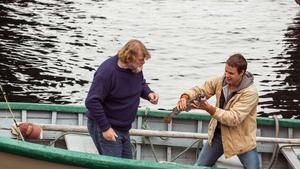
Don McKellar’s 2013 film The Grand Seduction, delves into the lives of those living in the small fishing town of Tickle Head, Newfoundland. The film follows the life of Murray French, a lifelong resident of Tickle Head who is determined to reinvigorate and restore his once esteemed town. When Murray was but a young boy, the town of Tickle Head was comprised of a strong community, who collectively shared a sense of purpose and a hard work ethic. The residents of the town were able to live in domestic bliss by fishing, however, as the years went by the fishing industry slowly desiccated, and the town became ravaged by poverty. Throughout the film, there are several fishing scenes that are depicted, all of which highlight animal-human interaction or presence. These specific scenes also emphasize the significant relation that the residents of Tickle Head have with the fish living in their harbor.
The film’s initial scene depicts a beautiful town, comprised of dignified, hard working fisherman headed off to sea. In this scene, director Don McKellar is able to exemplify how the ability to fish has given these men both dignity and purpose. As a result of this animal-human interaction, the residents of Tickle Head are able to provide for their families and sustain their town. This scene highlights the specific relation that exists between humans and animals in the film. The residents of Tickle Head are linked to the animals due to the fact that without them, they are unable to sustain a living. The fish in Tickle Head are evidently portrayed as being the town’s most significant asset.
A second scene in the film depicts Murray French and Doctor Paul Lewis fishing together in a small canoe, off the coast of Tickle Head. This particular scene is quite significant due to the fact that is symbolizes how the act of fishing experienced a paradigm shift throughout the film. During the onset of the film, fishing is highlighted as being the primary cause for the town’s prosperity and harmony. Fishing is exemplified as being an esteemed profession at the start of the film however, in this particular scene fishing is depicted as being a dreary, leisure activity for the unemployed citizens of Tickle Head. The significant animal-human relation that once existed between the citizens of Tickle Head and the fish of their harbor appears to have become rather lifeless. At the end of the scene both characters return to shore looking quite disappointed. Murray French is depicted carrying merely two fish after several hours out at sea, while the Doctor is seen empty handed. This particular instance epitomizes the disappointment the citizens of Tickle Head have been experiencing for years, in regards to the inability to sustain the town through fishing.
A final scene in the film portrays Murray and Doctor Lewis once again fishing. After a heartfelt discussion, Doctor Lewis is finally able to catch what he believes to be a live fish. He reels the fish out of the water, and pulls it into the boat in order to examine it. In this scene, the Doctor is entirely unaware that Murray had orchestrated the whole event, and had actually placed a dead fish in the water for him to catch. At the end of the scene, the citizens of Tickle Head are gathered together at the town bar, in order to celebrate the Doctor’s catch and eat the fish together. This specific scene is a significant moment in the film due to the fact that it portrays the astounding impact that fish have on the small community, and how merely one fish can cause the community to convene and celebrate.
These specific scenes in The Grand Seduction, clarify the notion that a crucial animal-human relation exists between the citizens of Tickle Head and the fish living in their harbor. It is made evident throughout the film that the town to Tickle Head is deeply connected to the fish they catch, and in a sense are forever indebted to those animals.